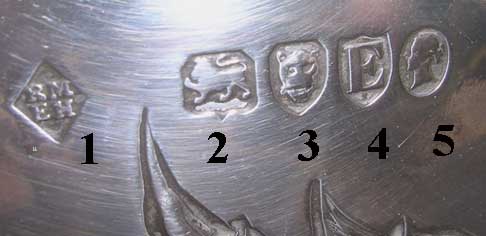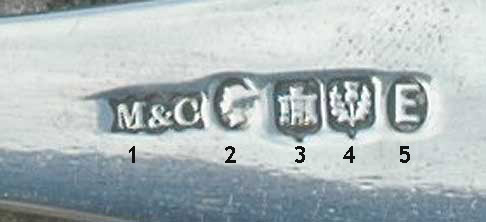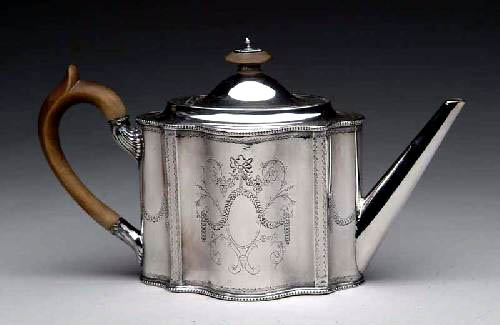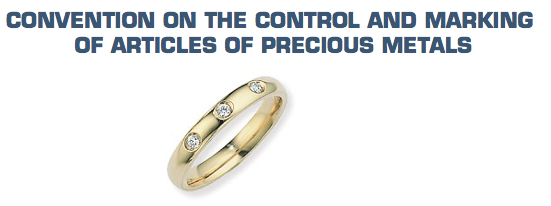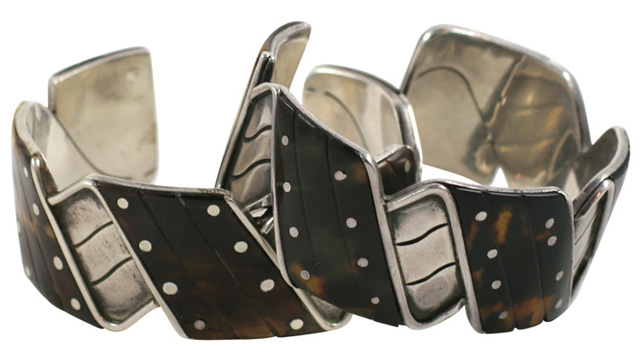Many people ask about the silver hallmarks that are located on sterling silver flatware, tea sets, and hollowware.
Buying a piece of antique silver can be quite a daunting exercise, especially if it is an expensive piece. However if the guidelines in this article are followed then the buyer will have a sound base from which to act. Never be frightened to ask the dealer questions, as all reputable dealers are more than willing to help. There are many good books on the market that give details of hallmarks. Amongst them are Bradbury’s; Jacksons’s Hallmarks and Miller’s Guide to Buying Silver. All are available in good bookshops and are an excellent source of information.
A silver hallmark is nothing more than an indication of metal content and its purity or quality. It may or may not include the manufacturer’s mark or location of origin. A manufacturer’s mark or “maker’s mark” alone are not necessarily considered hallmarks.
The word hallmark is derived from London’s Goldsmiths’ Hall of the Worshipful Company of Goldsmiths, the originator of Britain’s first hallmarks, which still maintains a record of all British Sterling Silver Hallmarks. Depending on country of origin, hallmarks can also include symbols for place of origin. Sterling silver hallmark etching and engraving have been in use in England and France since the 14th century. Most other European countries also use hallmarks. The United States has never used hallmarks per se.
The British system of hallmarking is somewhat complex, but relatively easy to follow once the system is deciphered. British Sterling Silver Hallmarks include a fineness or purity mark, an assay office mark, a date letter, and usually but not always, a maker’s mark.
1 Maker’s Mark – Richard Martin & Ebenezer Hall.
2 Lion Passant – Sterling Silver Mark.
3 Assay Office Mark – London Post 1821.
4 Date Letter –‘E’ for 1880.
5 Monarch’s Head – (Victoria) showing duty paid.
NB Monarch’s Head no longer stamped after 2nd May 1890
1 Maker’s Mark – Mackay & Chisholm.
2 Monarch’s Head (Victoria) showing duty paid. Discontinued after 1890.
3 Assay Office Mark – Edinburgh Assay Office
4 Thistle indicating sterling silver. This is the Assay Master’s Mark and is equivalent to the lion passant in England
5 Date Letter – 1861 (Different shape E from first example).
The assay mark. the famous lion. This silver hallmark testifies that the piece has been tested as sterling silver, i.e., an alloy that is 92.5% pure silver. Prior to 1831, this was the mark of the lion passant guardant — (in heraldic terms, the lion walking to the left with its head turned to look at the spectator). After 1831, the head was turned from full face to profile (the lion passant).
The town mark. This is the mark of the city where the assay office was situated. The first assay office was in London, its mark of a leopard’s head (wearing a crown until 1831) is still in use today. Edinburgh and Dublin, the capitals of Scotland and Ireland, were soon granted assay offices, and provincial English cities such as York, Chester, Norwich and many others soon followed. Sheffield and Birmingham, which both began assaying silver in 1773, are the only cities outside of London whose assay offices are still working. Their town marks of an anchor (Birmingham) and a crown (Sheffield) are the most frequently found after London’s leopard’s head.
The date letter. Each year, which runs from May till April, is allocated a different letter. A cycle of 20 letters is used (omitting J, V, W, X, Y, and Z) so there are five cycles in a century. Each cycle has its own style of letter and/or its uniquely shaped shield. The original purpose of this letter was not to record the year in which the piece was assayed, but to identify the Assay Master (who was appointed annually in May) so that he could be called to account if he passed lower grade silver as sterling. To be pedantically correct, the date of silver should include two years, for example 1783-4, but in practice we usually use only the first of the years that the letter spanned, e.g., 1783.
The maker’s mark. This consists of his or her two initials (except in the Britannia period from 1695 to 1720 when the marks was the first two letters of his name). Early makers often used an emblem with or without their initials.
On English silver, the lion passant (walking lion) is the symbol for sterling silver (925). If your piece has the Lion Passant or the number 925 then it is, in all probability, Sterling Silver. If it has the numbers ‘900’, ‘850’,’800′ or similar, then this would be the silver content (per thousand) of the silver alloy used.
When Buying Antique Silver Use The Following Checklist
1. Is the piece fully marked?
2. Are all the hallmarks consistent with the purported date of the piece?
3. Are any of the hallmarks distorted, over-struck or in an unusual position?
4. If there are several pieces in the set do they all carry the same hallmarks?
5. Are there any signs of repair or damage to the piece?
6. Will the dealer give you a receipt giving full details of the piece, its date and details of the hallmarks? –IF NOT RE-CONSIDER BUYING IT
7. Do you like the piece?
8. Buy the very best that you can afford but always look for value for money
9. Do not rely on the piece to rise in value and bring a large profit
10. ABOVE ALL ENSURE THAT YOU ARE DEALING WITH A REPUTABLE DEALER
Credit: http://www.wheathills.com


